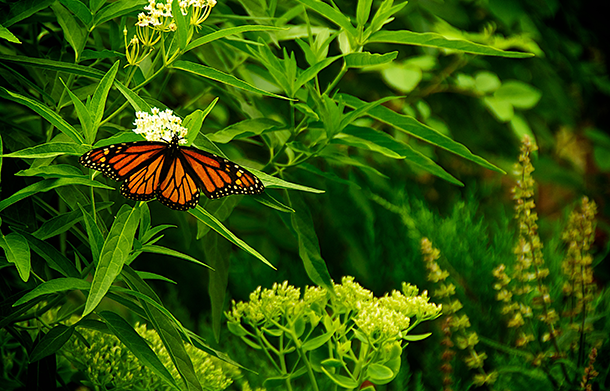Suing to Save the Monarch
Air Date: Week of May 6, 2016

A monarch butterfly (Photo: bark, Flickr CC BY 2.0)
Two environmental groups have sued the U.S. Fish and Wildlife Service in an attempt to compel it to formalize Monarch butterfly protection. But expert opinions differ on whether a ‘threatened’ status under the Endangered Species Act will help, or harm, the fragile creatures. The Allegheny Front’s Julie Grant investigates.
Transcript
CURWOOD: It’s Living on Earth, and I’m Steve Curwood. The steep decline in the North American Monarch butterfly population has won this spectacular creature its day in court. In March, two environmental groups filed suit against the U.S. Fish and Wildlife Service for failing to protect Monarchs under the Endangered Species Act, and to compel the agency to set a date to address the matter. But not all the supporters of the creature think listing the Monarch as endangered is the way to go, as the Allegheny Front’s Julie Grant reports.
GRANT: Tierra Curry grew up in Appalachia, and remembers the mountains teeming with big orange and black Monarch butterflies. Today, she’s senior scientist at the Center for Biological Diversity, and says the number of Monarchs has declined more than 80-percent from the twenty-year average.
CURRY: Back in the mid 1990s there were nearly a billion Monarchs, and the last two years, the population have been the lowest population sizes ever recorded.
GRANT: And Curry says they could easily be wiped out. In 2002, one winter storm killed more Monarchs than currently exist.

Tierra Curry, senior scientist at the Center for Biological Diversity, says listing monarch butterflies as threatened under the Endangered Species Act would help protect the fragile insects. (Photo: courtesy of Tierra Curry)
CURRY: Because they all go to the mountains of Mexico for the winter and they cluster on these trees in this small area, they’re incredibly vulnerable to bad weather. And this year in particular with El Niño, they’re threatened by severe storms and by drought.
GRANT: Curry’s group, along with the Center for Food Safety, petitioned the U.S. Fish and Wildlife Service in 2014 to list Monarchs as threatened under the Endangered Species Act. The agency launched a review. It’s supposed to take 12 months to decide. But 2015 came and went without a decision. And the environmental groups are suing.
CURRY: We want to get a legally binding date from the Fish and Wildlife Service, when they’ll make a decision whether or not to protect the Monarch under the Endangered Species Act.
GRANT: Georgia Parham is a spokesperson for the U.S. Fish and Wildlife Service. She says Monarchs are one of many important species being reviewed for Endangered Species Act listing.
PARHAM: The Monarch petition is one of about 500 petitions that we are looking at.
GRANT: When someone petitions the agency to list a species, Parham says they look at how the species is doing, the threats to it, and how those fit with the listing criteria. And that can take a while. But she says it doesn’t mean nothing is being done.
PARHAM: A species doesn’t have to be listed for other federal agencies to start looking at it and planning for conservation. But with species like the Monarch, we’re out ahead of that.

Monarchs lay their eggs on the underside of the milkweed plant’s leaves in early spring (Photo: USFWSmidwest, Flickr CC BY 2.0)
GRANT: She says Monarchs already get a lot of attention, in part because people miss seeing this once-common beauty in the backyard. And because President Obama prioritized Monarchs in his federal pollinator strategy. The government is working with Mexico and Canada, with states, and private landowners to rebuild habitat and plant milkweed - the only food Monarch caterpillars eat.
They need to restore tens of millions of acres of habitat, according to Chip Taylor. He’s an insect ecologist at the University of Kansas, and director Monarch Watch, a non-profit group working to help Monarch recovery.
TAYLOR: The federal government does not have enough federal land in the Midwest, even in the upper Midwest, to provide enough habitat on that federal land that would improve monarch butterfly numbers.
GRANT: Taylor says they need private landowners to get on board - to work with the federal government.
TAYLOR: We’re talking about very conservative areas of the country. Kansas, Oklahoma, and Texas, which are really important pivotal states for this monarch production.
GRANT: He thinks listing Monarchs under the Endangered Species Act - at top down approach - would be counter productive.
TAYLOR: I think what we would see here is that milkweed would disappear overnight. Nobody would want to have it on his landscape, simply because this would mean regulation. People don’t want regulation.
GRANT: But Tierra Curry at the Center for Biological Diversity wants a legally binding agreement on protecting monarchs, before a new president takes over in Washington.
CURRY: It’s possible that the next administration might not prioritize endangered species at all. And at that point it’s really important to have a legally binding date for this decision, or the decision could get put off forever.
GRANT: Curry expects to settle on a decision date with the Fish and Wildlife service on when a decision will be made about listing monarchs out of court. I’m Julie Grant.
CURWOOD: Julie Grant reports for the Allegheny Front.
Links
More about the monarch butterfly from the Center for Biological Diversity
U.S. Fish and Wildlife Service: “Save the Monarch”
Living on Earth wants to hear from you!
Living on Earth
62 Calef Highway, Suite 212
Lee, NH 03861
Telephone: 617-287-4121
E-mail: comments@loe.org
Newsletter [Click here]
Donate to Living on Earth!
Living on Earth is an independent media program and relies entirely on contributions from listeners and institutions supporting public service. Please donate now to preserve an independent environmental voice.
NewsletterLiving on Earth offers a weekly delivery of the show's rundown to your mailbox. Sign up for our newsletter today!
 Sailors For The Sea: Be the change you want to sea.
Sailors For The Sea: Be the change you want to sea.
 The Grantham Foundation for the Protection of the Environment: Committed to protecting and improving the health of the global environment.
The Grantham Foundation for the Protection of the Environment: Committed to protecting and improving the health of the global environment.
 Contribute to Living on Earth and receive, as our gift to you, an archival print of one of Mark Seth Lender's extraordinary wildlife photographs. Follow the link to see Mark's current collection of photographs.
Contribute to Living on Earth and receive, as our gift to you, an archival print of one of Mark Seth Lender's extraordinary wildlife photographs. Follow the link to see Mark's current collection of photographs.
 Buy a signed copy of Mark Seth Lender's book Smeagull the Seagull & support Living on Earth
Buy a signed copy of Mark Seth Lender's book Smeagull the Seagull & support Living on Earth

